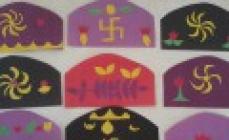.. 11 12 14 ..
FORGING GOLD AND SILVER
The bars or tiles of gold obtained after casting can be immediately subjected to rolling, but it is better to forge them first.
Forging is done carefully: they begin with weak hammer blows and gradually move on to stronger ones; from time to time gold is calcined and cooled in water or, as the masters say, "soaked". Forged in this way: first one side of the ingot, then the opposite, and finally, with hammer blows, sharp edges and corners are dulled; the latter is done to avoid the formation of captivity during rolling. Forging is carried out either only with the wide part of the hammer - "striker", or, if you want to pull the ingot more, then at the end work with the narrower part of the hammer. In the described way, the malleability of cast gold is significantly increased. Before rolling, the gold is heated and cooled again.
In general, it must be remembered that in a red-hot state, gold should not be forged or rolled in rollers, since it then cracks, and that malleable gold with more or less prolonged mechanical processing becomes hard again and can give cracks and flaws; therefore, when forging, rolling in rollers or in cieisen, the gold must be calcined from time to time.
If cast gold during processing with a hammer, despite repeated calcinations, remains brittle, this means that there is some harmful impurity in it (sulfur, tin, zinc, antimony, etc.); such gold cannot be rolled into plaques or pulled into a wire, as it will tear; it needs to be cleaned.
Silver bars and tiles require less elaboration than gold bars; they are heated, allowed to cool somewhat and put into the rollers. Sometimes, before rolling, silver ingots are hammered, which is done in order to flatten the ingot somewhat, smooth out irregularities on it, dull sharp edges and corners, and generally give the ingot a shape that is convenient for rolling. During forging, silver must be calcined from time to time, since the metal becomes hard during prolonged processing and calcination returns it to its former softness. Silver can be forged and rolled in rollers, even red-hot, and therefore there is no need to soak it; conversely, soaking makes the silver hard and therefore inconvenient for forging or rolling.
If gold and silver were cast not into metal molds, but into sand molds, then the ingots are unclean, namely: they contain small particles of foundry sand on the surface. Such ingots must be cleaned from the outside with a special scraper before forging or rolling, otherwise the sand particles will scratch the rolls.
It is also necessary to pay attention to the following circumstance: the calcination of gold and silver (in a furnace or on a brazier) is always carried out on pure charcoal; coke should not be taken at all, since it contains sulfur, which, when calcined, can partly turn into gold and silver, and the metal will turn out to be brittle.
Non-ferrous metal does not contain iron or includes a small fraction of it. It is these raw materials that are used by the best blacksmiths for the manufacture of original decorative and functional elements. Working with compositions is a real art that requires special tools, knowledge and experience. Non-ferrous scrap (alloys of brass and bronze, aluminum and copper, platinum, silver and gold) is used for the production of forged interior decorations. Forging such metals is difficult because their compositions are highly conductive. The material is heated and treated with gas.
Features of forging bronze
Bronze is used for the manufacture of highly artistic objects; experienced craftsmen with outstanding taste can work with it. Used for work metal with silicon impurities. An alloy of iron, aluminum and copper is also used for hot rolling and casting. When heated, the composition will change color from yellow to orange, so it is important not to overheat it. The blacksmith, knowing the peculiarities of the alloy, will bring the mass to the required temperature and only after that will he start processing it.
The finished metal is quite tough, it is not easy to work with it (it practically does not bend or straighten). But the edges of the forged product remain strong and strong, so thin spirals and curls can be made from them, which will be even and smooth.
Features of forging copper
Copper is very easy to work with because the metal has a wide operating temperature range. Using scrap and waste of non-ferrous metals for work, the master can make large parts. Copper is a malleable metal, therefore it is suitable for stamping and bending. It is not necessary to preliminarily anneal it, since it does not have a work hardening.
Copper should be heated until red. Even when using a large piece, no additional heating is required. A mixture of gases is used to weld individual elements during forging.
Features of forging aluminum
Strong and strong, lightweight and reliable material is used in various industries. The alloy is popular in the aviation and space industries. Aluminum makes it possible to obtain light and strong elements for parts of aircraft and spaceships, stations, satellites. The composition is also used in the manufacture of forged products.
Heating is carried out in special closed ovens powered by electricity. Aluminum takes longer to heat up than steel. Before working with heated aluminum, the blacksmith must also warm up his tools (up to 200-250 degrees). To simplify the workflow, scrap metal, small ingots or rectangular billets are used for work.
Aluminum adheres to the die, so thoroughly polish the surface before working with it.
Features of forging brass
Metal is used for the manufacture of various thin-walled elements and decor. Brass is strong and non-corrosive, but it is inflexible. Various grades of metal are used for the manufacture of forged products. A composition with a high copper content is often used, in which case craftsmen will be able to obtain a pliable and flexible material. In blacksmithing, special grades of brass are used with the addition of various alloying components.
Features of forging silver
Since ancient times, silver has been used by blacksmiths to make exquisite forged household items. In skillful hands, silver becomes a decorative adornment. Special tools are used to work with metal. Before processing, it is strongly heated. Often, blacksmiths make small ingots and bars, foil and thin-walled elements from silver.
Usually, non-ferrous metals contain little or no iron in their composition. These include: aluminum, alloys of bronze and brass, silver, gold, and platinum. As a rule, they are applied in the form of alloys using alloyed elements.
Forging such metals is difficult, due to their high degree of conductivity, so they are heated with gas. Forging non-ferrous metals requires quite complex skills and knowledge from the master, and therefore his work can be very highly paid. Jewelry forging is especially appreciated, because not everyone will be able to make high-quality items from silver and gold - this requires a special hand. And artistic taste, especially when it comes to silverware.
Forging bronze
Highly artistic products have always been made of bronze, so working with it requires not only skill, but also extraordinary taste. Usually, not pure metal is used, but an alloy of bronze and silicon. It is composed of copper, iron and aluminum. However, many experts believe that there is very little bronze in such an alloy, because it does not include tin.
Therefore, it can be called binary alloys, which is more correct from a scientific point of view. It is also suitable for casting and hot rolling. When such a composition is heated, the color of the metal changes from yellow to orange. That makes it easier to work with it - knowing the required color, the master will never overheat the bronze product, and even a novice blacksmith will be able to easily remember the colors of heating the metal.
It also has another, but already unpleasant feature - it is extremely rigid, and therefore the workpieces from it are extremely difficult to bend or straighten. But the edges of the product do not crack, which allows them to be made very thin, and the curls of bronze will come out smooth and also beautiful.
Forging copper
Extremely lightweight, because the metal has the widest operating temperature range. It also has excellent pliability, and therefore it rarely breaks during bending or stamping. The difference between copper is that it does not need to be annealed, because there is no work hardening.
Even if a fairly large piece of copper is used, additional heating is not required. If metal sheets are processed, they are heated to a red color, and then quenched in water, the sheet is ready for subsequent use.
Given the softness of copper, it is necessary to plan the sequence of stages and processes before starting work. Otherwise, easily bending parts will be deformed, because they are easily deformed even in a cold state. If in the process of forging copper it needs to be welded, it is better to use a mixture of gases. Preheating will also be necessary as copper has a high melting point.
Aluminum forging
Parts for various high-tech industries, for example, for the aviation industry, are made from aluminum and its alloys, because such metals are very light, but their strength does not suffer from this. Usually, the process of heating aluminum takes place in special electric resistance furnaces, because it heats up more slowly than, say, steel.
In the process of stamping aluminum, which can take place with a hammer or press, a number of nuances must be taken into account. Before forging aluminum, the entire forging tool is heated to a temperature of 200-250 ° C, which complicates the work with metal.
To make punching easier, you should use rectangular ingots or billets, because round ingots are cracked. Another feature of aluminum is that it sticks to the die, so it should be carefully sanded before use.
Brass can be used to make many thin-walled products, pipes, wheels, gears and many more different parts and things.
This metal is characterized by strength, not susceptibility to oxidation, but brass products are not quite ductile. Today, for the needs of the industry, many grades of metal are required, therefore it produces seven types of ordinary, as well as eighteen types of special brass.
Hand forging brass is a rather difficult business, so metal grades containing a high percentage of copper are used for it. This allows you to achieve the necessary qualities: plasticity, pliability of brass. Used in blacksmithing and special grades with the addition of alloying components.

Silver forging
Silver forging was carried out in ancient times, because it is a soft malleable silvery white metal, which is perfectly processed in skilled hands. Silver is processed with the help of special tools, because it is simply unacceptable to use ordinary blacksmith's hammers, which does not allow the size of the processed silver, because the metal is very expensive.
Usually, jewelry forging is engaged in the manufacture of blanks from metal: ingots, silver bars, as well as foil. The peculiarities of the metal are such that it does not need to be heated very much, because it is already malleable. But for more delicate work, for example, making jewelry, jewelry forging is no longer used. Indeed, today very different methods are used to produce bracelets or silver chains.
Conclusion
The processing of non-ferrous metals using forging has not lost its relevance, although today in most cases they are not done manually, without the use of machines. And the processing of non-ferrous metals has its own nuances.
For example, given the properties of bronze, it is practically not used in its pure form, but even its alloys are difficult to forge, because it has extremely low ductility. The situation is different with copper, but it has another drawback - small parts of the product bend even when cold. But when processing aluminum, all forging tools should be heated to a sufficiently high temperature.
Items made of silver and brass also require a special approach. Considering all the difficulties with metals, she has always been trusted by real craftsmen. And although now it takes place mainly with the help of special machines, the process did not require less knowledge and skills from this.






